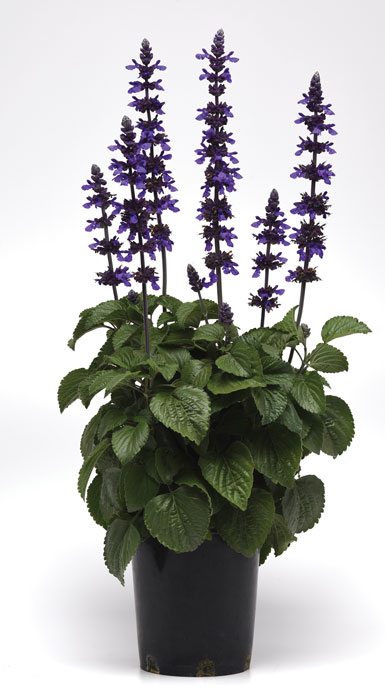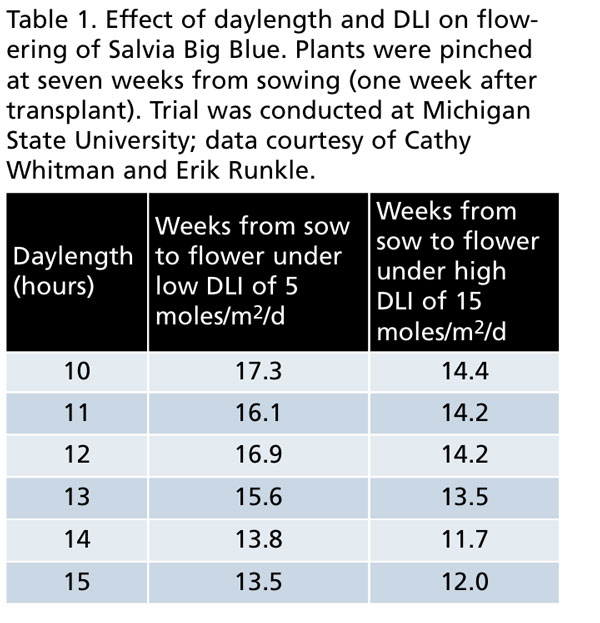11/1/2018
Growing Big Blue
Mary O’Connor

This year’s university performance trials have shown that the new interspecific Salvia Big Blue is one to watch. The University of Georgia placed it in its Best of the Best category and it was named a 2018 Top Performer at the LSU Hammond Research Station Ornamental Plant Trials. This first-of-its-type-from-seed salvia is a big-size beauty that’s set to pump up your mid-Summer sales. It’s super showy at retail and in the landscape for the end user. The plants send out blue spires continuously from July to first frost with little to no extra care.
Big Blue also meets and exceeds the needs of pollinator-friendly gardens and designs, attracting hummingbirds, butterflies and bees of all sorts. It tolerates the heat and even low-water conditions—a big win for all levels of enjoyment!
The key to producing this stunner and timing it for key sales windows is proper lighting and growth control. Here are growing guidelines from the experts at PanAmerican Seed:
Germination & plug stage
Salvia Big Blue is supplied as raw seed. We recommend one seed per cell in either a 288 or 128 tray with an initial media pH of 5.5 to 5.8. Covering the seed is optional; germination takes place in four days. Maintain a Level 4 (medium-wet) moisture during Stage 1 at a temperature of 68 to 77F (20 to 25C).
During Stage 2, provide medium moisture at Level 3 to 4 and maintain soil temperature. Provide light at 1,500 to 2,500 f.c. (16,100 to 26,900 Lux) and apply fertilizer less than 100 ppm N. In Stage 3, moisture can be lowered to Level 2 (medium-dry) and temperatures can lower slightly to 68 to 72F (20 to 22C). Increase light to 3,000 f.c. (32,300 Lux) and maintain the fertilization rate.
It’s at this stage you should provide a daminozide 2,500 ppm spray, roughly two weeks after sow, and repeat in seven to 10 days as needed for growth and flower control. Other options are an ancymidol 5 ppm spray or a paclobutrazol 5 ppm spray.
In Stage 4, lower temperatures again to 62 to 65F (17 to 18C) with light and fertilizer maintained from Stage 3. If you’re growing plugs under short days, lighting the plug with daylength extension can accelerate flowering. Salvia Big Blue has a facultative long day flowering response with an optimal daylength of 14 to 15 hours and it’s a light accumulator with hastened flowering under high daily light integral (DLI).
Growing on to finish
Key tips for finishing Big Blue after transplant include proper daylength, pinching and appropriate PGRs. After transplant, lighting to 14 or 15 hours with daylength extension elicited fastest flowering. In an experiment conducted at Michigan State University under low DLI of 5 moles/m2/d, plants grown at 10-hour daylength flowered approximately four weeks slower than plants grown at 14- to 15-hour daylength, respectively (see Table 1).
 Do not exceed 15 hours because daylength of 16 hours or four-hour night interruption slowed flowering in some trials and is under further investigation. In regions with high DLI, daylength extension may not be needed.
Do not exceed 15 hours because daylength of 16 hours or four-hour night interruption slowed flowering in some trials and is under further investigation. In regions with high DLI, daylength extension may not be needed.
In Michigan State University’s trial, plants grown at a high DLI of 15 moles/m2/d flowered two to three weeks earlier than those grown at a low DLI of 5 moles/m2/d under 10- to 15-hour daylengths (Table 1).
Salvia Big Blue earns its name—it is big!—so creating the desired habit with a pinch and proper PGR is important. A soft pinch at six weeks (14 to 21 days after transplant) OR a hard pinch (leaving four nodes) two to three weeks later will provide a better habit.
Salvia Big Blue is highly responsive to daminozide and repeated applications as needed in finish are very effective at controlling height. Alternatively, paclobutrazol may be used in the final stages after axillaries are actively growing, at rates of 3 to 5 ppm drench. The use of paclobutrazol will minimize the delay of flowering. (Rates recommended are for the Midwest and may need to be adjusted for your location and conditions.)
Finishing in gallons is preferred for late spring and summer. Big Blue may also be finished in 5- to 6-in. pots without flowers in nine weeks for the professional landscape input. Lighting to set buds is still recommended, where daylength is less than 14 hours, to provide fast flowering and best in-ground performance. Once in flower, Salvia Big Blue will stay in flower, no matter the changing daylength, well into autumn. GT
Mary O’Connor is a global product manager for PanAmerican Seed, stationed at its Elburn, Illinois, facility. For full culture and trial details, visit panamseed.com/culture.